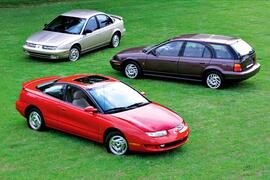 GM pumped money and people into the Saturn brand but it was to no avail
GM pumped money and people into the Saturn brand but it was to no avail
"Saturn is the key to General Motors’ long-term competitiveness, survival and success as a domestic producer,” boss Roger Smith stated boldly in January 1985.
The idea for this new brand had been secretively formulated three summers prior by senior engineer Alex Mair, at a highly troublesome time for the US industry.
The name hints at the patriotic mission, being borrowed from the rockets that beat the Soviets to the moon.
American manufacturers were haemorrhaging domestic market share. Oil crises in 1973 and 1979 had massively raised fuel prices, causing consumers to abandon Detroit’s gas-guzzling barges for smaller, more efficient cars from Japan – which also turned out to be better to drive and of high quality.
GM had seen its annual US sales drop 34% in the four years up to 1982, while Chrysler’s had fallen 27% and Ford’s plummeted 47%.
Making Saturn succeed would resemble rocket science, though: previous attempts at ‘all-American import-busters’ had been, said Autocar, “ignominious engineering and sales failures” and even cars shipped over from Japan were going to have a circa- $1700 advantage over a US-made one no matter what.
Enjoy full acccess to the complete Autocar archive at themagazineshop.com
Investment of some $4.3 billion was planned to set up Saturn not merely as a new GM brand but a quasi-independent, corporation, employing 20,000 people.
This included building the biggest manufacturing facility in GM history. At 3.8 million square feet, Spring Hill in Tennessee covered most aspects of car production, to avoid cross-country shipping of parts – “as close as the US can get to the cost efficiencies of just-in-time manufacturing”.
It would implement lessons from GM’s Nummi venture with Toyota in California, regarding quality assurance and a collaborative, not confrontational relationship between labour and management.
In a similar vein, Saturn would have fewer dealers covering larger areas in order to reduce retail costs.
It had become less ambitious by the time Saturn was ready to launch in 1990 (investment about $2.8bn, jobs created 6000), but still new GM boss Lloyd Reuss believed “it can be used to improve the competitiveness of the whole organisation”.
Autocar checked back in a year after the S-series saloon and coupé models had gone on sale: “This first term has been a tough one. It started with a lukewarm reception to the cars. Then followed a painfully slow production build-up and, most recently, a safety-related recall.”
Not helping was perfecting the process for Saturn’s one big innovation: cloaking a steel spaceframe in rust- and dent-resistant thermoplastic.
Furthermore, the Gulf War had just ignited and the US had sunken into a deep recession, causing new car sales to fall by as much as 30%.
On the bright side, Saturn had topped the annual JD Power dealer satisfaction survey – a feat that it would often repeat with car buyers in the years to follow.
They were the sort of customers Saturn had hoped for, too: those who would otherwise have bought a Honda Civic or Toyota Corolla (50% had traded in a ‘foreign’) and younger buyers (average age of 41).
The brand continued to prosper through the decade – indeed, there were even whispers of exports – and hit two million sales in 1999, just before it moved onto the L-series.

And then the rot started. Saturn had created resentment within GM during its creation for gobbling up cash needed by established brands, and as the SUV market took off, the shoe was put on the other foot.
The incumbent management also wanted Saturn to start doing things the conventional GM way. Its plastic bodies, for one, took more time to make and required unappealingly large and uneven panel gaps.
In 2004, Saturn’s special union agreement was dissolved, making its workers no different than other GM staff. In 2007, Spring Hill was retooled to make steel bodies.
And the new generation of Saturns were familiar to Americans as Chevrolets and Pontiacs and to us as Vauxhalls. They didn’t even rename the Astra.
Saturn’s unique selling points had been stripped from it, and so when the onset of the Great Recession left GM bankrupt in 2009, it was put on death row with Hummer, Pontiac and Saab. Oh, what could’ve been.